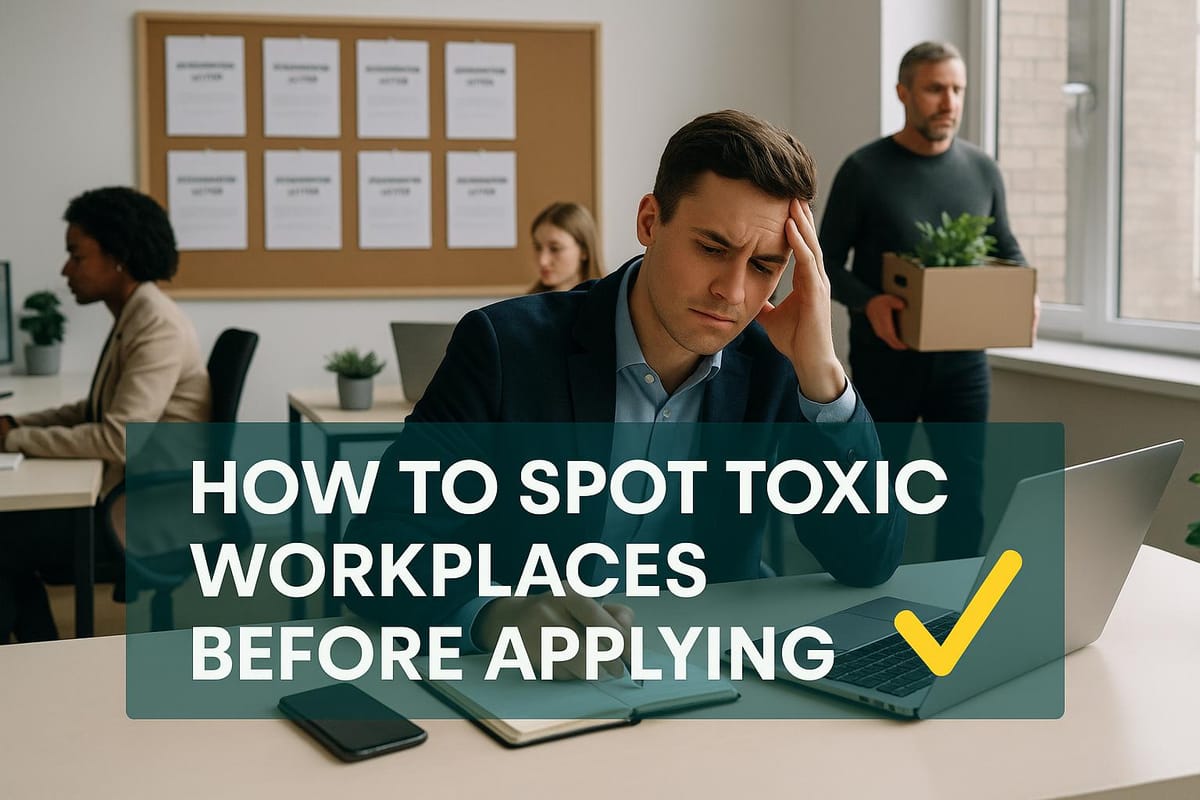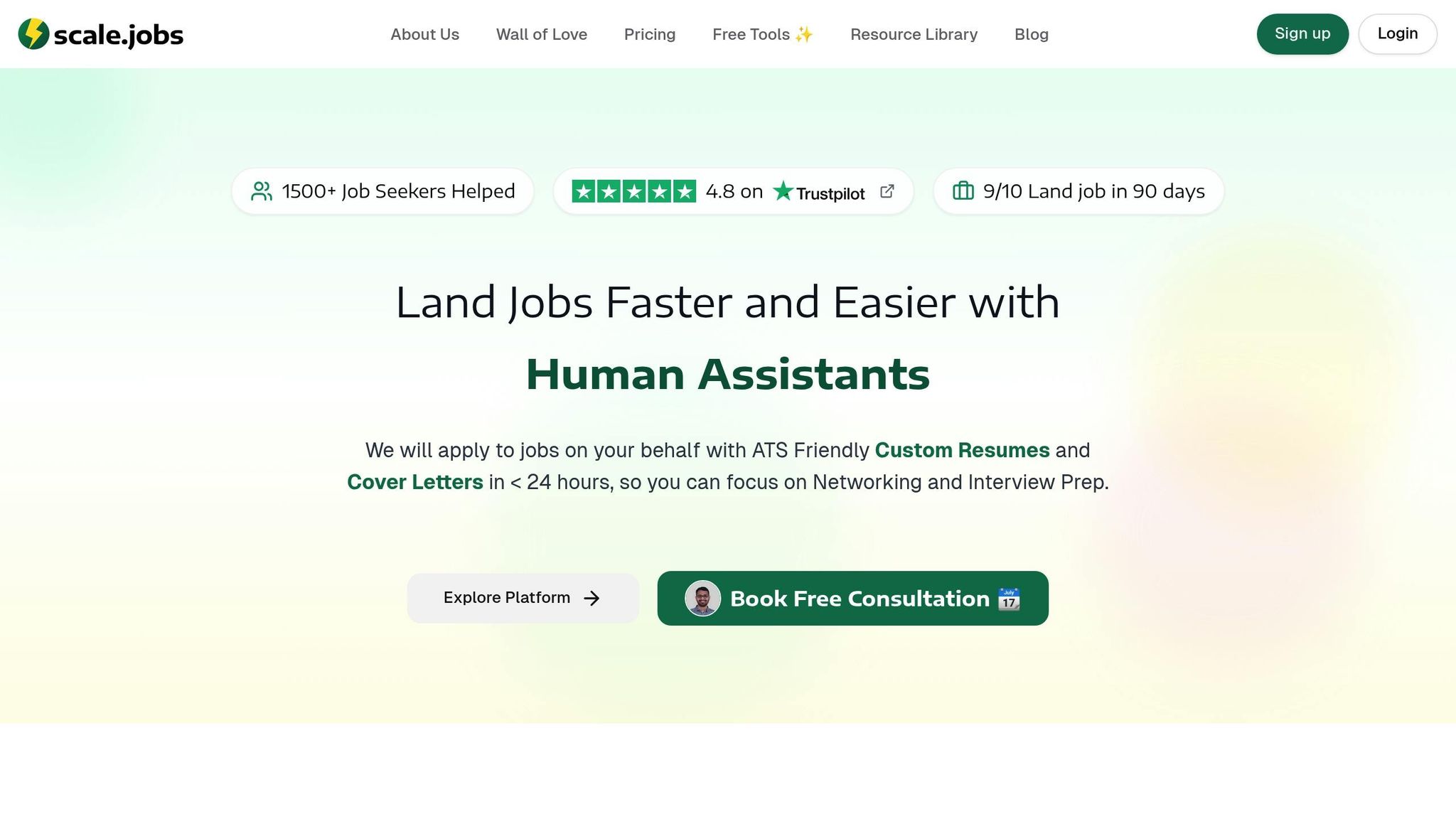How to Spot Toxic Workplaces Before Applying
Learn how to identify toxic workplaces before applying for jobs by spotting red flags in communication, turnover, demands, and favoritism.

Toxic workplaces can harm your mental health, career growth, and overall well-being. Before applying for a job, it’s crucial to identify warning signs that might indicate a negative work environment. Here’s how you can spot red flags and make informed decisions:
- Poor communication: Look for signs of unclear guidance or frequent changes in expectations.
- High turnover rates: Frequent employee departures often signal deeper issues.
- Unrealistic demands: Watch out for mentions of excessive workloads or unattainable goals.
- Favoritism: Unequal treatment can erode trust and morale.
To avoid these pitfalls, research companies using platforms like Glassdoor or LinkedIn. Pay attention to employee reviews, tenure patterns, and company news. During interviews, ask about career development support to gauge the organization’s priorities.
Tools like scale.jobs can help you analyze job postings and flag potential issues. This platform combines human oversight with advanced tools to provide insights into workplace practices, ensuring you avoid toxic environments.
105 - How to Spot TOXIC Workplaces: 10 Interview Red Flags
What Makes a Workplace Toxic
Toxic workplaces often follow similar patterns that not only create stress but also drain productivity and push talented individuals out the door. Spotting these warning signs early can help protect your career and overall well-being. Here are some key red flags to watch for during your job search.
Poor communication is a classic indicator of workplace toxicity. When management fails to provide clear guidance or frequently changes expectations without notice, employees are often left to rely on rumors to stay informed. This lack of clarity fosters confusion, uncertainty about job performance, and even concerns over job security.
Another major red flag is high employee turnover. If a company seems to have a revolving door of employees, it’s often a sign of deeper problems with leadership or the overall work culture. Pay attention to how long employees typically stay and whether leadership roles change frequently - short tenures and constant reshuffling can point to serious issues.
Unrealistic expectations and deadlines are another hallmark of a toxic environment. When employees are pushed to work excessive hours to meet unattainable goals, it not only affects the quality of their work but also their well-being. Workplaces that glorify "hustle culture" often leave employees feeling perpetually behind and burned out.
Favoritism and unequal treatment also hint at a toxic atmosphere. When certain employees are granted better opportunities or more flexible schedules based on personal relationships rather than merit, it can erode trust and morale across the team.
These warning signs often go hand in hand, creating an environment filled with stress, frustration, and dissatisfaction. Being able to recognize these patterns during your job search can help you steer clear of workplaces that might jeopardize your long-term happiness and success.
How to Research Company Culture Before Applying
Before hitting "submit" on that job application, it's a good idea to dig into a company's culture. Doing some homework can help you avoid potential pitfalls, like high turnover rates or unresponsive management. Trusted sources and online platforms are great tools to uncover what it’s really like to work there.
Check Employee Review Sites
Platforms like Glassdoor, Indeed, and Comparably are goldmines for understanding employee sentiment. Look for recurring themes in reviews - whether positive or negative. But be cautious: a sudden surge of overly glowing reviews could mean the company is trying to bury less favorable feedback.
Analyze LinkedIn Employee Data
LinkedIn can provide valuable insights into a company’s workforce. Check employee profiles to see how long people typically stay in their roles or whether there’s a pattern of frequent departures. It’s also helpful to see how employees describe their experiences and roles in their own words.
Look Up Company News and Legal Issues
A quick search for news articles or public records can reveal important details about a company’s reputation. Legal disputes, layoffs, or other controversies might be signs to proceed with caution.
Use scale.jobs for Better Company Research

If you’re looking for a more streamlined way to evaluate companies, scale.jobs has you covered. Their free Job Board pulls together thousands of job postings every month, making it easier to spot trends, like repeated openings for the same position. Plus, their Job Applications Tracker helps you organize your research, flag potential red flags, and keep track of key questions to ask during interviews.
What sets scale.jobs apart is its focus on quality and personalized support. Unlike platforms like Find My Profession or LazyApply, scale.jobs offers human assistance for deeper, qualitative insights. This added touch can help you zero in on companies that align with your values and career ambitions.
Red Flags in Job Descriptions
Job postings can often reveal more about a company's culture than they intend. By paying close attention to the language used, you can spot potential warning signs of a toxic work environment. Here are some key phrases to look out for in job descriptions.
Warning Signs in Job Descriptions
Certain phrases in job postings can hint at deeper issues within a company. For instance, describing the workplace as a "fast-paced environment" might sound appealing at first, but it can sometimes translate to constant chaos and never-ending, unrealistic deadlines.
Another common phrase, "we're like a family", may seem warm and inviting but could signal a lack of boundaries. This often means the company expects employees to prioritize work over personal life, sacrificing their time and energy without limits.
Be cautious of vague expectations such as "always available" or "flexible schedules." These phrases often indicate poor work-life balance and a lack of respect for personal time.
Unrealistic job requirements are another red flag. Demanding extensive experience with technologies that have only recently emerged or expecting entry-level candidates to have advanced skills shows misaligned expectations and poor understanding of the role.
Finally, watch out for over-the-top terms like "passionate self-starter", "rockstar", or "ninja." These buzzwords often point to high-pressure environments with frequent burnout and high turnover. Similarly, urgent calls for "immediate start" or "ASAP" without a clear reason suggest poor planning and a revolving door of employees.
Interview Questions That Reveal Toxic Workplaces
An interview isn’t just about impressing the company - it’s also your chance to evaluate if their culture aligns with your values. One effective way to do this is by asking smart questions that dig into their approach to career development.
Questions About Career Development
How a company invests in its employees' growth speaks volumes about its work environment.
"Can you share an example of how the company has supported an employee’s development?"
This question can reveal a lot. A good answer might include stories of promotions, mentorship programs, or access to professional training. If the interviewer struggles to provide specifics, it could mean employee growth isn’t a priority.
Pay attention to their tone and delivery. A confident, detailed response shows a genuine commitment to development, while vague or hesitant answers could hint at deeper issues.
Ultimately, a lack of focus on growth often ties back to broader red flags - like misaligned values or inadequate support - that might point to a toxic workplace.
scale.jobs vs Other Job Search Platforms
Finding a job search platform that can help you identify potential red flags is crucial for steering clear of toxic workplaces. While many platforms focus on mass applications and resume optimization, they often miss the subtle warning signs hidden in job postings. That’s where scale.jobs stands out.
What Makes scale.jobs Stand Out
scale.jobs combines advanced software tools, AI-powered assistance, and human oversight to create a transparent and reliable job search experience. The platform provides real-time WhatsApp updates, complete with time-stamped, proof-of-work screenshots, ensuring you stay fully informed throughout the process. Unlike platforms that rely solely on automation, scale.jobs employs human assistants to carefully review job descriptions and flag potential concerns that algorithms might miss.
With a flat-fee pricing model, refunds for unused credits, and free tools like an ATS checker, salary predictor, and interview questions predictor, scale.jobs simplifies and enhances your job search. These features not only set it apart from the competition but also address key shortcomings in other platforms.
Platform Comparison: scale.jobs vs Competitors
Find My Profession focuses on reverse recruiting, emphasizing resume and LinkedIn profile optimization. While they aim to align roles with your career goals, they lack the transparent, human-driven process offered by scale.jobs.
- Real-time WhatsApp updates with proof-of-work screenshots
- Transparent flat-fee pricing with refund options
- Human-assisted review of job applications
LazyApply automates the process of sending mass applications but lacks human oversight. This approach can result in applying to roles with obvious red flags that a human reviewer would catch.
- Human verification to avoid toxic workplaces
- A quality-over-quantity approach to applications
- Dedicated support throughout your job search
Jobscan is designed to optimize resumes for ATS systems, focusing on keyword matching. However, it doesn’t address workplace quality or hiring practices, leaving a gap that scale.jobs fills.
- Evaluates workplace culture beyond ATS optimization
- Human assistants offer insights into hiring processes
- Comprehensive job search support instead of a single-tool focus
TealHQ uses AI to provide job insights and track applications. While helpful, their AI-driven approach misses the nuances that human insight can capture.
- Human-verified detection of potential workplace issues
- Transparent, real-time communication
- Flat-fee pricing instead of a subscription model
Take Control of Your Job Search
Steering clear of toxic workplaces is essential for safeguarding both your mental health and career growth. By identifying potential red flags early, you can make better decisions about where to invest your time and energy - after all, you’ll be spending over 40 hours a week there. The tips and tools we’ve discussed can help you take charge of this process.
Start with solid research. Platforms like Glassdoor and Indeed are great for digging into employee reviews, while LinkedIn can reveal patterns in employee tenure. Don’t stop there - scan recent news about the company to uncover any hidden issues. This groundwork prepares you to ask sharp, well-informed questions during interviews.
When you move to the interview stage, ask strategic questions that reveal deeper truths about the workplace culture. Pay attention not just to the answers but also to what’s left unsaid. Vague responses or attempts to dodge your questions might indicate underlying issues.
For an extra layer of protection, leverage tools like scale.jobs to analyze job postings for warning signs. Unlike automated platforms such as LazyApply, scale.jobs combines human insight with technology to catch subtle red flags that algorithms might miss. Their human assistants can even evaluate job descriptions and hiring practices for problematic language. Plus, their flat-fee model eliminates recurring costs, and real-time updates via WhatsApp - with time-stamped proof-of-work screenshots - offer full transparency.
Avoiding toxic workplaces is non-negotiable if you want to protect your professional reputation and mental health. Taking the time to evaluate potential employers thoroughly ensures you’re setting yourself up for long-term success.
To strengthen your position, use scale.jobs’ free tools like the salary predictor and interview questions predictor. These resources can help you prepare for negotiations around pay and workplace expectations, giving you an edge in the hiring process.
FAQs
How can I use employee review sites to spot signs of a toxic workplace before applying?
Employee review platforms like Glassdoor can be a helpful resource when you're trying to spot potential problems within a company's culture. The key is to look for patterns in the reviews rather than focusing on one-off complaints. If you notice recurring themes - like poor management, struggles with work-life balance, or high turnover rates - it’s worth paying attention.
Pay special attention to feedback about leadership. Comments that touch on communication issues, lack of support, or micromanagement can be telling. Similarly, consistent complaints about long hours, unrealistic demands, or rigid policies might hint at deeper cultural challenges. While pay and benefits may not directly define a company's culture, dissatisfaction in these areas could reflect larger organizational issues. Approach reviews with a critical eye, weighing both the positive and negative to get a well-rounded view.
What are the best interview questions to ask to identify a toxic workplace?
To spot potential signs of a toxic workplace during an interview, it’s important to ask questions that shed light on the company’s culture, management approach, and how employees are treated. Here are a few examples:
- How does the team handle conflicts or disagreements? This can give you a glimpse into how the company approaches communication and resolves issues.
- What does success look like in this role, and how is it measured? This question helps clarify the expectations and whether they align with achievable goals.
- Can you share an example of how the company supports employee growth and development? If the answer seems vague or lacking, it could point to limited opportunities for growth.
While listening to their responses, pay attention to the interviewer’s tone, body language, and level of detail. Hesitation, overly vague answers, or a defensive attitude could hint at deeper problems. Beyond the interview, you can also check employee reviews on platforms like scale.jobs to gather more insights about the workplace before deciding to move forward.
How can I identify a toxic workplace before applying for a job?
Spotting a toxic workplace before you apply is a smart move to protect both your mental well-being and career trajectory. A good starting point is checking out company reviews on platforms like Glassdoor or Indeed. Look for patterns in feedback - things like complaints about poor management, frequent employee turnover, or a lack of work-life balance can be red flags. Also, take a look at the company’s social media and employee testimonials to get a sense of their workplace culture.
When you’re in the interview stage, use the opportunity to dig deeper. Ask questions like: What are some of the biggest challenges your team has faced recently? or How does leadership prioritize employee growth and well-being? Pay attention to how they answer - hesitation or vague responses might tell you more than the words themselves.
If you’re looking for tools to simplify your job search while gaining better insight into company culture, platforms like scale.jobs can be a game-changer. They offer features like AI-powered resume customization, interview preparation, and even human support to help you zero in on opportunities that align with your values - all while saving you time and effort.




